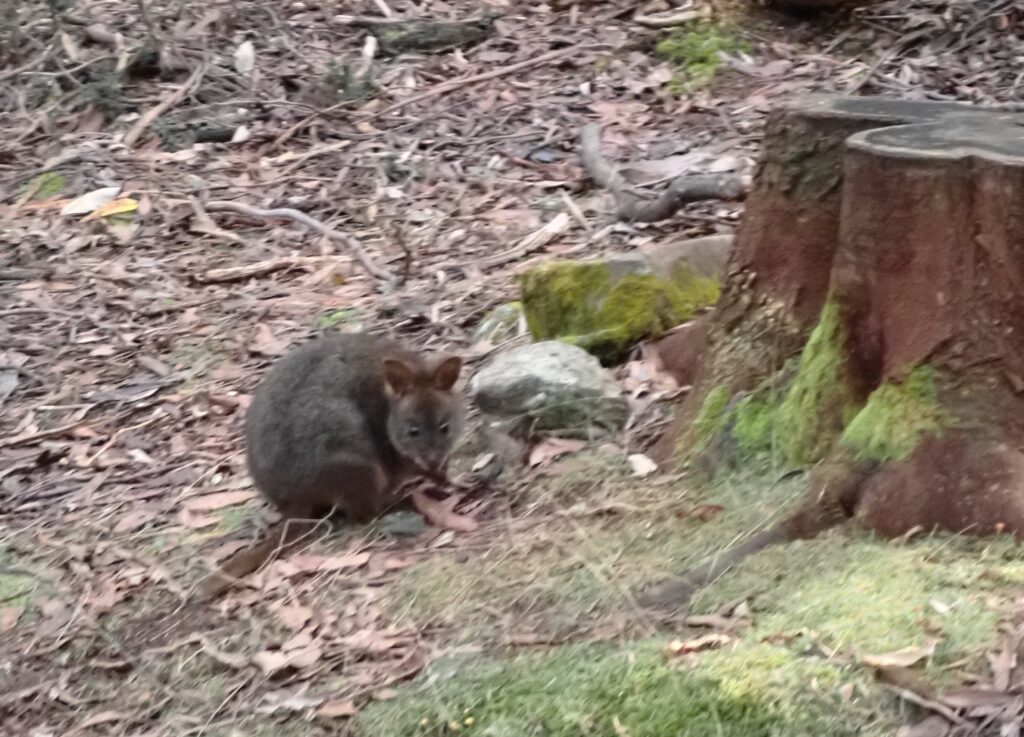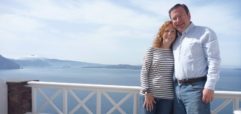Port Arthur is the historic site of the convict prison on the Tasman Peninsula. This is a world heritage site consisting of 11 remnant penal sites originally built within the British Empire during the 18th and 19th centuries. The sites are described as “the best surviving examples of large-scale convict transportation and colonial expansion of European powers through the presence and labor of convicts.”
Along the way we made a couple of stops. The first was besides some roadkill. We spotted a dead Devil on the side of the road. They are endangered so Astrid stopped to check to see if there were any Joeys, babies, in the pouch that might have survived. There were none.
We next stopped along the shore to view a blowhole that had developed through erosion of the sandstone. And then at an overlook across the bay from the site of the prison complex.
In reality we were told, the entire Peninsula was the prison, on the one side was the water, on the other was a chain of dogs. Though it was clear there were many escapes and convicts went into the bush to escape the harsh treatment within the prison walls.
At the entrance we were each given a playing card that you could find on the walls hiding drawers that would identify you as one of the inhabitants of the prison. My card, the 10 of diamonds, identified me as the doctor. So naturally we eventually had to check out the infirmary.
Cathy’s card identified her as Joseph Boss William Woolnough, a Clergyman who purchased the Separate Prison intending to turn it into a high-class hotel.
We walked the grounds and briefly joined a tour where the guide was explaining about the life and conditions the prisoners lived under. The main building was originally constructed as a mill for flour. But the water pressure was not strong enough to power the mill stones. So the convicts were enlisted to power the wheel. They would take 15-minute turns on the wheel then have to step off while the wheel was turning. Take a 15-minute break and then try to step back on, all while the wheel continued to turn.
We boarded a boat for a 20-minute turn around the bay. The captain explained that just across from the men’s prison, was the juvenile prison for boys ages 9 to 15. This was the first juvenile prison in the British Empire, and it was intended to separate the boys from the “criminal university” of the men’s prison. Though in fact the men had to transport supplies across the bay, so it did not completely isolate the young boys from the hardened criminals.
Returning to the dock, we walked up to the commandant’s house. Then through the guard tower and then to the infirmary. Next, we visited the asylum, where the “lunatics” and the paupers were held. Next was the Separate Prison, which was built later with the intent to replace physical punishment, flogging and such, with psychological punishments, solitary in a completely dark and soundproof room for those incorrigible inmates.
We continued to walk the grounds, through an arbor of trees planted as a Soldiers Memorial. We passed the area of housing for the higher ups, such as the Doctors and Clergy. We passed through the remains of the church and then to the Magistrates house and garden.
We stopped for lunch and continued our way back to Hobart. Along the way we stopped for a brief walk to a natural occurring geological phenomenon “Tessellated Pavement”.


So great!
Thanks for sharing👏💕👍